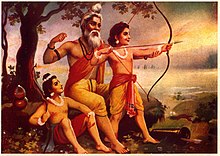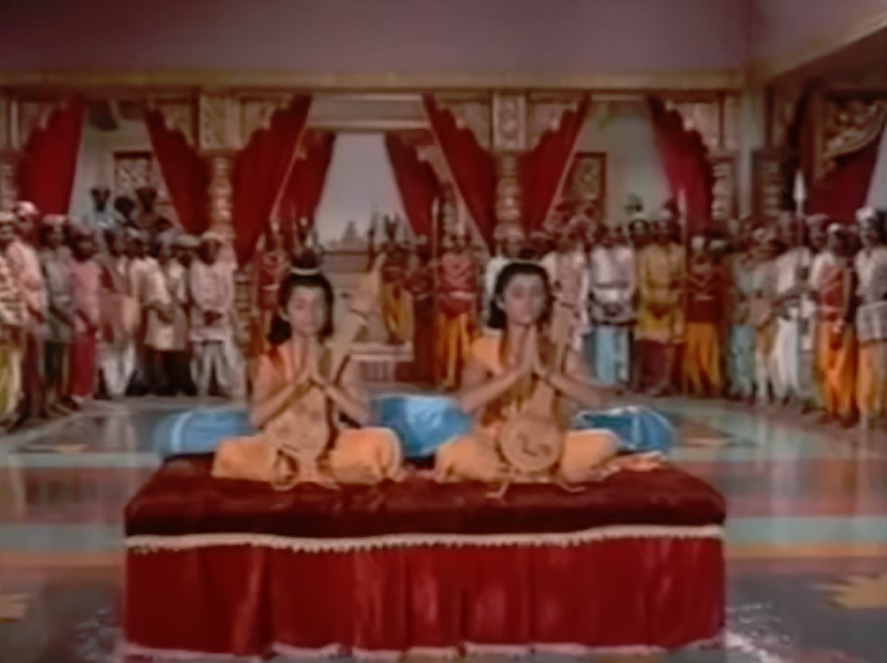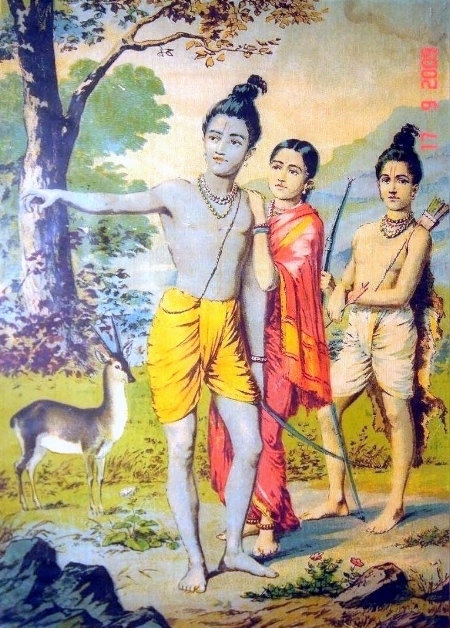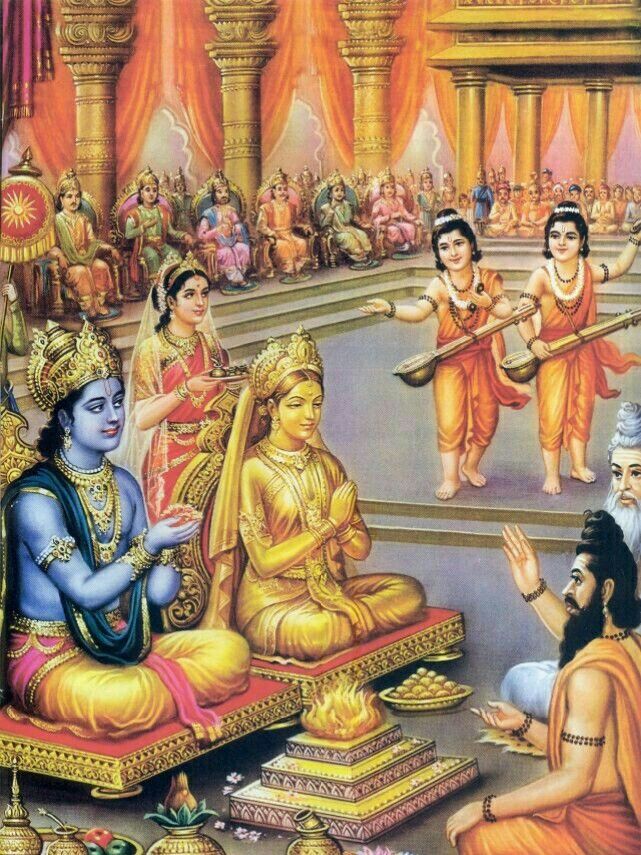Sita, abandoned by her husband Ram, found love and support from Valmiki and his disciples in the Ashram. Especially the female ascetics took special care of her, as she was pregnant.
After a few months, Sita gave birth to twin boys. Valmiki blessed them, naming them Lava and Kusha. Lava, the youngest, was like his mother Sita in features, complexion and mannerisms, fair and gentle. Kusha had his father’s features, complexion and mannerisms, dark and kind.
They were brought up by the guidance and teachings of Valmiki, their beloved Guru. Valmiki taught them everything they needed to learn including the Vedas, martial arts, and war tactics. But especially, he taught them the “Ramayana,” the story of Rama, the king of Ayodhya, a poem he composed. They learned to recite the Ramayana, accompanied by a musical instrument called the “veena.”
 Lava and Kusha enjoyed singing the Ramayana, but without knowing that they were singing about their own parents’ story, as Valmiki had promised Sita that he would not reveal her identity to anyone, which included Lava and Kusha. Valmiki also taught them special astras (energetic weapons), to be used only in unavoidable situations. The twins were great in their studies as well as in combat training.
Lava and Kusha enjoyed singing the Ramayana, but without knowing that they were singing about their own parents’ story, as Valmiki had promised Sita that he would not reveal her identity to anyone, which included Lava and Kusha. Valmiki also taught them special astras (energetic weapons), to be used only in unavoidable situations. The twins were great in their studies as well as in combat training.
Meantime in Ayodhya, the wives of Rama’s three brothers (Mandavi, Urmila and Shrutakirti) also gave birth to two children each. Lakshmana and Urmila had Angada and Chandraketu. Bharata and Mandavi had Thaksh and Pushkal. Shatrugna and Shrutakirti had Subahu and Shatrughati.
As much as these events were to be celebrated, somehow things were not the same in Ayodhya ever since Sita was sent away. Rama couldn’t be himself without his beloved wife Sita. Rama’s state affected all in Ayodhya Kingdom. Rama didn’t have the heart to see the people and help their lives as a king. Ayodhya started to dim in its glory. The royal mothers were very worried. Vasishtha, Rama’s Guru wasn’t pleased with what was happening either. He needed to do something to restore the glory and happiness back to Rama-Rajyam (Rama’s Kingdom), Ayodhya.
At Valmiki’s Ashram, Lava and Kusha were preparing for their journey to Ayodhya. They were going to fulfill their Guru Valmiki’s command to recite the Ramayana there. They went to their mother to get her blessings. Sita blessed them and told them to meet Rama, the hero of the Ramayana, and to get his blessings before coming back to the Ashram. The twins were very excited to have a chance to meet Rama and Sita in Ayodhya.
They started their journey towards Ayodhya by singing the story of Rama along their way in all the villages and cities. They were instructed by Valmiki to introduce themselves as his disciples, which they did proudly. People in thousands gathered to see the twins recite the Ramayana.
The news about two young children reciting Rama’s story reached the palace grounds. The queen mother, Kaushalya requested her guards to invite these children to perform in front of her and the rest of the royalty. The twins were very happy that they had a greater chance of meeting Rama and Sita at the palace.
 When the children arrived at the assembly, their looks and divine presence mesmerized everyone. When they started singing, the audience was in awe about their talent and their devotion to the King Rama. Rama himself heard them singing and rushed there to hear them. The minute he saw them, he felt something in his heart.
When the children arrived at the assembly, their looks and divine presence mesmerized everyone. When they started singing, the audience was in awe about their talent and their devotion to the King Rama. Rama himself heard them singing and rushed there to hear them. The minute he saw them, he felt something in his heart.
After the twins finished reciting the Ramayana, he inquired about the composer of this beautiful poem, and asked the children who they were. They answered that they were disciples of Maharishi Valmiki, who composed the poem and taught it to them. Rama felt some sort of happiness after a very long time. He wanted to reward them with jewels and pearls. They refused to accept any gifts and only wanted to see the queen, Sita, as they were so eager to meet her. Without a word, Rama turned and went into his chamber, his head bent down in sorrow.
The twins worried that they said something to hurt Rama. They asked Kaushalya, “Did we say something wrong, to hurt our hero, King Rama?” With a heavy heart and eyes full of tears, the queen mother broke the news that Sita been sent away. The children were very disappointed to hear about Rama renouncing his wife in order to fulfill his duty as a king to his constituents. They were too small to understand the sacrifice that Rama had made. They were angry, to a level of hating Rama, for him making such harsh decision. They went back to the Ashram convinced not to sing Rama’s story anymore, as they felt betrayed by Rama due to his actions towards Sita.
Sita was waiting at the Ashram, eager to ask the twins about Rama. But she saw their disappointment and anger in their faces. She asked them about Rama’s well-being. The twins answered with disgust that he was doing fine. Then she asked why they were annoyed and angry. Thus Sita came to know about what had happened at the palace.
 She advised her children not to be angry, explaining that Rama has to follow his dharma as a king, fulfilling the laws of the land. The children were not ready to accept her argument, also saying they were worried about what would have happened to Sita in the forest. They also told her their decision not to sing Ramayana any more. Sita was devastated to hear the children feeling such hatred towards Rama, as she was expecting the exact opposite from them after they met him.
She advised her children not to be angry, explaining that Rama has to follow his dharma as a king, fulfilling the laws of the land. The children were not ready to accept her argument, also saying they were worried about what would have happened to Sita in the forest. They also told her their decision not to sing Ramayana any more. Sita was devastated to hear the children feeling such hatred towards Rama, as she was expecting the exact opposite from them after they met him.
Whatever Sita said didn’t appease the children. Finally, Sita said that she would not speak to them ever again if they don’t sing the praise of Rama. Without any other way, half-heartedly, the children agreed to continue to sing the Ramayana, for the sake of their mother’s happiness.
In Ayodhya, poverty and depression was on the increase. Drought was taking hold. Food shortage was becoming a big issue and, the never-before heard word in Rama-Rajyam, crime was staring to take root. Maharishi Vasishtha, Guru of Rama, had to do something to get Ayodhya out of the desperate situation it was in.
After a lot of thought, consulting with the queen mother and Rama’s brothers, he decided to ask Rama to perform a ceremony named “Ashvamedha,” for the benefit of the kingdom. In an Ashvamedha yaj~na, a horse with the king’s flag was sent on a tour through all the lands, to return to the yaj~na if no one opposed it or imprisoned it. If it was imprisoned, the king will have to free it by peace or force.
Hearing this from his Guru, Rama was puzzled because a king without a queen cannot perform this yaj~na. The only way to perform this mighty yaj~na would be for Rama to remarry. When this was suggested, Rama became unusually angry and outright rejected the plan. He told everyone that he is a follower of the ‘eka-patni-vrata’ (vow of loyalty to one wife), that his love for Sita was only for her and cannot be shared with anyone else. Rama was a living example of righteousness. He said he couldn’t even dream of being with another woman.
Vasishtha suggested they make a golden statue of Sita, to have next to Rama while conducting the yaj~na. Rama agreed, only to fulfill his duty as a king. The citizens of Ayodhya brought all the gold they had, to be used for the statue of Sita, saying that the state of the land was their fault to begin with.
This was the first time they were able to see Rama after Sita was sent away. They were so happy to see their king. The statue was made and the yaj~na begun. Rama’s brother Shatrugna led Ayodhya’s army, following behind the horse, chosen especially for the tour of the land, carrying Ayodhya’s flag.
The news of Rama’s Ashvamedha Yaj~na reached Valmiki’s Ashram. Sita was devastated to hear the news, as she knew a king had to have his wife in order to perform such a ritual. She fainted, as she couldn’t bear the thoughts of Rama with another queen.
 Rishi Valmiki knew what was happening with Sita and went to her rescue. While she was unconscious, he was able to transmit his meditative energy, to lift Sita out of her physical body on a trip to Rama’s chamber in Ayodhya. Sita saw the devasted Rama treating her golden statue as her, pouring his heart out to the statue.
Rishi Valmiki knew what was happening with Sita and went to her rescue. While she was unconscious, he was able to transmit his meditative energy, to lift Sita out of her physical body on a trip to Rama’s chamber in Ayodhya. Sita saw the devasted Rama treating her golden statue as her, pouring his heart out to the statue.
This made Sita even sadder, but at the same time relieved that her husband’s love for her had not diminished. Seeing her husband’s devotion towards her, even after he had renounced her, brought peace to Sita. She travelled back to the Ashram, reentered her physical body and thanked Valmiki for the revelation.
She was filled with remorse and shame that she doubted her beloved husband, so she wanted to do reparation for her action. As suggested by Rishi Valmiki, Sita decided to do a puja for Mata Lalita Devi, to be done uninterrupted for ten days. For the puja she needed one thousand lotus flowers. Lava and Kusha promised to bring them to her.
Guru Valmiki had an important event to attend and left the ashram for a few days. Sita started her puja and immersed herself in the worship of Mata Lalita Devi.
More to come…
